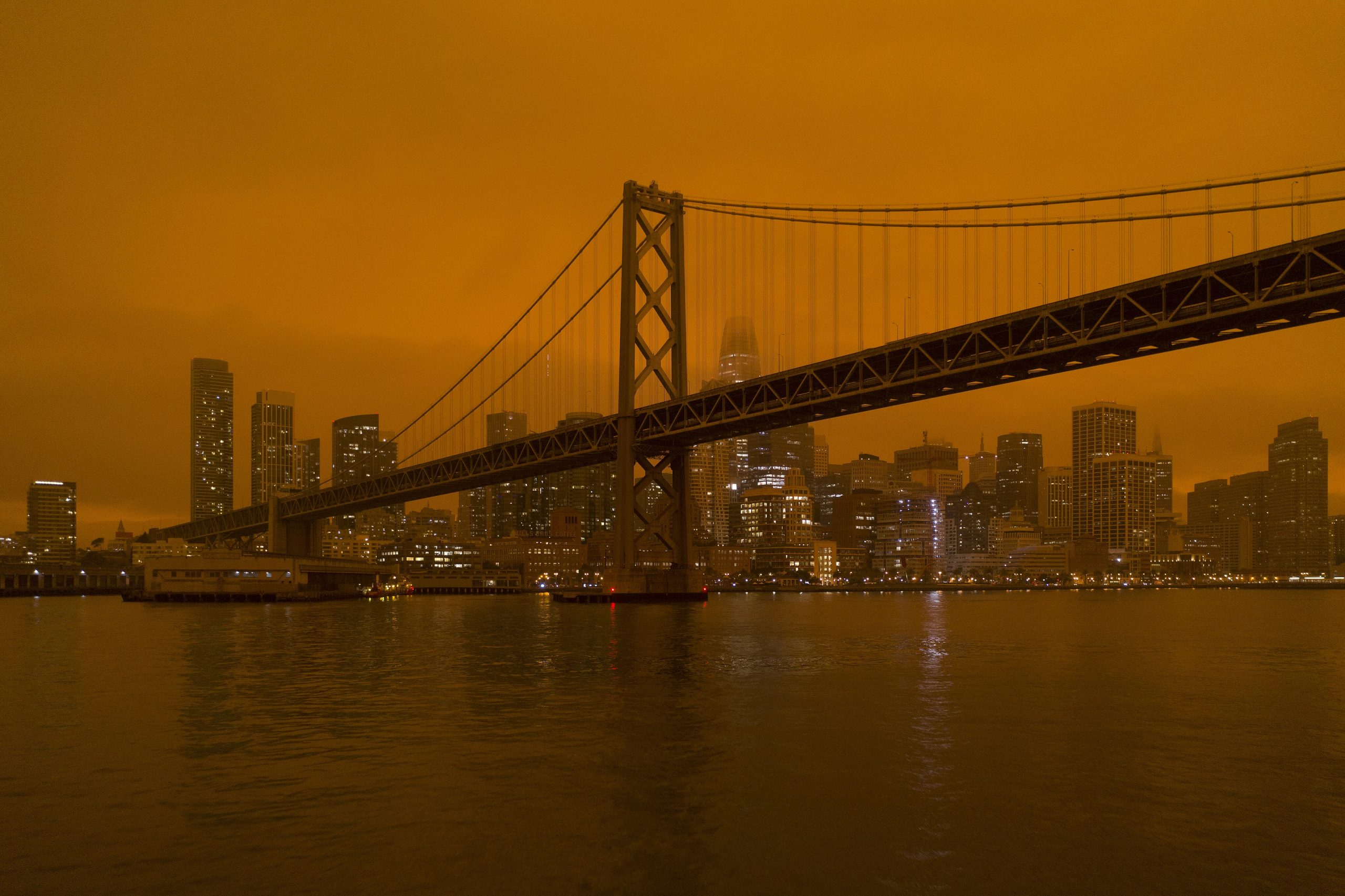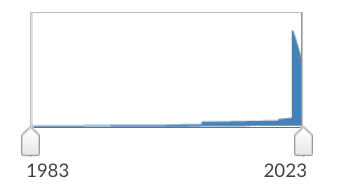
September 1, 2023, by Brigitte Nerlich
Orange is the new bleak*
I was recently reflecting on the way extreme weather events manifest themselves in different colours. Floods are brown and ugly; there is brown flood water and then there is brown mud everywhere (more on that here). Wildfires are orange and, in a sense, beautiful; there are orange sunsets and sunrises, but what’s left behind is a stark landscape painted in charcoal.
Today I want to delve a bit into the orange skies of wildfires and see how they are talked about, what emotions, as well as aesthetic and cultural associations they evoke, and whether that might provide us with opportunities to think about climate change in a different way.
I searched ‘all English language news’ on the news data base Nexis with the search terms “wild fire” OR “wildfire” AND “orange sky” and got about 900 hits (I will only be able to dip rather randomly into these news items). The timeline shows that newspapers started to use these words in in earnest after about 2020 (the graph is produced by Nexis and doesn’t provide any info about years and numbers).
Eerie orange skies
A 2002 fire in Arizona provoked a comment that resonated with me, as I had had similar emotions when my sister sent me photos from wildfires in New Mexico in 2011 and 2022: “If it was a sunset, it would be pretty, the almost-eerie red-orange sky over parts of Arizona, but it’s not. It’s fire creating that color, and, for the people in the towns said to be in the path of the fire they are calling the monster, it is downright scary”. (MSNBC Show, July 2022)
The same year, 2002, Canada too was hit by wildfires and the word ‘eerie’ came up again in an article covering these disasters: “Fires raging about 1,000 kilometres north of Montreal covered the city with an eerie orange sky, thick haze and fine grit Sunday, pushing smoke across Ontario to the U.S. as far south as Washington, D.C.” (The Gazette, Montreal, Quebec, June 2022).
A year later, in 2003, a town which has been recently affected by fires was affected then too. “At an up-scale subdivision on the outskirts of Kelowna, residents sat on their porches Wednesday afternoon, watching the smoke billow into the glowing orange sky south of their homes.” (Times Colonist, Victoria, British Columbia, June 2002)
The same year, another Canadian newspaper reported on a photo depicting a scene that has now become commonplace: “On August 15, Fairview resident Margaret Hughes snapped a spectacular photo of a helicopter and bucket against the brilliant orange sky. It’s the definitive photo of the summer.” (Nelson Daily News, British Columbia, August 2003)
An iconography of wildfire and an aesthetics of disaster began to emerge over time, as wildfires continued to burn across the world and more and more people became eye witnesses of eerie orange skies.
Ominous orange skies
2020 seems to have been a real turning point, a crunch year in orange sky appreciation. Huge fires ravaged California on 9 September 2020 and Wikipedia now has an entry called “Orange Skies Day”.
It explains: “Orange Skies Day was a climatological event that occurred in the San Francisco Bay Area on September 9, 2020. Temperatures varied in different places, but the sky was overall orange. The orange-colored hue in the sky was the result of smoke from the North Complex Fire (including the Bear Fire) and more than 20 other wildfires, which burned more than 2 million acres east of the San Francisco Bay Area. This smoke scattered blue light wavelengths, which only allowed warmer colors to reach the Earth’s surface.” Such explanations of the colour of the sky would reappear in articles published in 2023 when smoke from Canadian wildfires reached New York.
The Wikipedia article goes on to note “In popular culture, the day was compared to the films Blade Runner 2049 and Dune.” Somebody on facebook said: “There were scenes in the movie Blade Runner 2049 where the sky was orange. This is now a reality today in California. Blade Runner 2049 was trying to show a dystopia.” Indeed, scenes in California were utterly hellish, with ash falling from the sky. Photos included the famous Golden Gate Bridge silhouetted against an orange sky, an image that became quickly iconic.
The Guardian columnist Rebecca Solnit used some evocative colour phrases when reporting on Californian fires: “The sky was the muddy yellow of an old bruise at 7am in San Francisco on Wednesday, and by eight it was a dull orange and the darkness that felt like night was coming on.” (September 2020) And even the year before, in 2019, The Guardian spoke of an “Eerily apocalyptic orange sky” and Vogue quoted a witness as saying: “One morning early last summer, I woke to a burnt-orange sky. The sun looked biblically dimmed.”
This biblical end-of-days feeling brought back memories of when the town of Paradise was destroyed in California in 2018: “Brimstone turns the air black, and a young boy asks his dad ‘Are we gonna die?’ It’s an eclipse saturated with a lava lamp glow of brimstone, and you gasp when someone points out that it’s only 11:38 a.m. These people aren’t just scared, but also confused; even though the area had a long and violent history of fires, it never seems real when your home suddenly goes up in smoke. The footage is horrifying, even at a time of such intense climate change that natural disasters can seem as regular as the weather.” (Newstex Blogs, IndieWIRE, July 2020)
One blogger said: “I’ve met many people who say that California’s 2020 orange sky day was the moment they understood what a warming world really looks like. It was a wake up call. Some changed careers. Others got politically involved. Maybe this week is that moment for people on the East Coast.” (Newstex Blogs, Coyote Gulch, June 2023) As the images became more and more apocalyptic, orange skies became portents of climate catastrophe, at least for some…
Apocalyptic orange skies
But 2020 was not only bad for California. It was also bad for Australia. Wildfire smoke from the 2019/2020 Australian fires reached New Zealand and even there scenes were described as “apocalyptic”. (London Evening Standard, June 2020) We all still remember pictures of people wading into the water on Australian beaches to escape the fires, scenes that would be repeated in the summer of 2023 in Rhodes, Greece, and Maui, Hawaii.
There was also no letup in wildfires in 2021 and 2022, a year when I wrote a blog post on wildfires in New Mexico entitled “The skies are falling and the trees are crying” in which I tried to capture the emotions they caused amongst those who live with the forests.
So we come to 2023. It all began with wildfires in Canada which would have gone unnoticed, probably, if the smoke hadn’t reached New York on 6 June. It turned the sky orange and produced apocalyptic images of, for example, the Empire State Building and other New York landmarks. This event seems to have finally awakened some concerns about climate change, the amplifier of extreme weather events.
Rolling Stone Magazine reported in June 2023: “Al Gore once told me, ‘When it comes to climate change, everyone has an ‘oh shit moment’ – that moment when it gets real, when they realize what is at stake.’ East Coasters are having an ‘oh shit moment’ right now. You look up at the sky and it’s orange, like Mars. And it’s deadly. Let’s hope too that the orange sky apocalypse erodes the myth that the climate crisis is something that happens to other people – mostly brown people and poor people who live in faraway places. These orange skies are battlefield skies, and the war to maintain a habitable planet has just begun.”
Again, we hear about hell and the apocalypse and references are made to the film Apocalypse Now and, again, to Blade Runner.
And then came Rhodes and Maui. Residents and tourists alike were affected, although, strangely, tourists kept coming even after the fires swept over the land and right into the sea, chasing people into it. A British tourist said in Rhodes that the “Sea turned black, sky orange, ‘like the end…” (Hindustan Times, July 2023). It is not surprising that the year before, in July 2022, The Times had reported that the wildfires raging then across Europe were like Dante’s Inferno. The 2023 infernos across Europe were again Dantesque.
Colours, culture and climate change
There have always been wildfires, but since the 1990s humans have started to notice something ever more sinister about them signalled by the orange sky that accompanies them. We are increasingly interpreting these signals as indicators of something beyond just incidental disasters related to a fire or many fires, but to a world that is metaphorically and systemically ‘on fire’ due to climate change.
This interpretation takes place within a cultural context in which the colour orange plays an important role. In the past, this colour may have signalled happiness, romantic love, hope of a new dawn and so on. Now it also signals fear, angst, bereavement and anger.
Given the wide spread of wildfires, everybody is becoming an eye witness as a resident, tourist or screen watcher. The effects of extreme weather are no longer just out there in the distance; they are above you in the sky, a sky shared by all. An iconography is gradually emerging of fires and skies and maps and fire fighters and planes and helicopters and iconic buildings against an orange sky and burned-out ruins left behind by the fires.
People are beginning to speak a particular ‘orange sky’ language. They either focus on the colour itself and use words like red, bright, dark, brilliant, burnt, blood…orange. Or they focus on the emotions evoked by the colour and use words like eerie, strange, ominous, and, increasingly, dystopian and apocalyptic. Some even say that the orange sky has an apocalyptic tint.
The colour orange is also associated with wider cultural narratives: the biblical or cinematographic apocalypse, the end of days and paradise lost, hell, ash and brimstone, Dante’s Inferno and more recent fictional dystopias like Blade Runner and Dune, and also the eerie and barren planet Mars.
Looking at wildfires through these linguistic cultural lenses or, indeed, just as they are, might provoke awe. As a September 2020 report on CNN said: “the apocalyptic images of the devastation wreaked by the West Coast wildfires, razed buildings, burning red skies cloaked in smoke have caused shock and awe around the world.” This feeling of awe might remind us of famous paintings by John Martin of the apocalypse (look at the paintings and then this photo from Rhodes) or paintings by JMW Turner of skies tinted orange by volcanic ash and gas after the Tambora volcano in Indonesia erupted in 1815.
Orange skies and all their cultural associations might make us see the world in different ways. They might inspire not only shock and awe but also thought and reflection on the wider issues of global warming. Who knows!
- New title suggested by Kate Stewart @katestew.art
Image: Smoke from the North Complex Fire settles over San Francisco, turning the daytime sky a dark orange. Taken on 9 September 2020, 12:15:50 by Christopher Michel. Wikimedia Commons.
No comments yet, fill out a comment to be the first


Leave a Reply